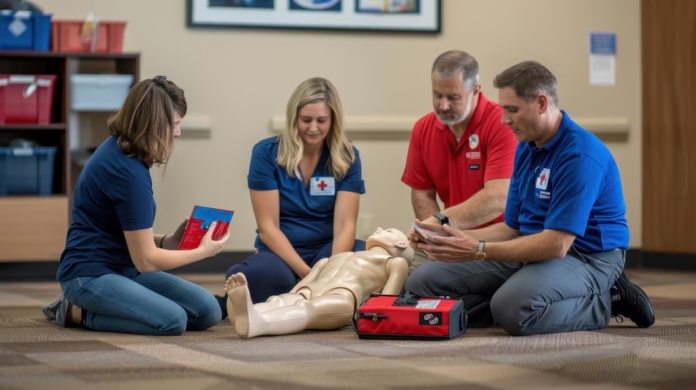Emergencies such as car crashes falls, or heart attacks can occur suddenly, leaving bystanders to provide crucial aid before professionals arrive. Knowing how to respond in these critical moments can make the difference between life and death. Let’s explore the essential concepts of the primary and secondary survey in first aid.
In this blog post, we’ll explore the essential steps of the primary and secondary surveys in first aid, providing you with practical tips and insights to handle emergencies effectively. By the end of this article, you’ll understand how to assess danger, check for responsiveness, and evaluate airway, breathing, and circulation (ABCs) – all fundamental skills in ensuring the safety and well-being of both responders and victims.
Understanding the Basics of Primary and Secondary Surveys
When you find yourself in an emergency, the first few moments are crucial. The primary and secondary surveys are structured assessments that first responders use to evaluate and manage the victim’s condition systematically. These surveys help prioritize care and ensure no critical details are missed.
What is the Primary Survey?
When a first responder checks a victim for immediate needs, it’s called the primary survey. The responder quickly checks for life-threatening conditions to keep both the victim and themselves safe.
Assessing for Danger
Before approaching the victim, it’s vital to assess the scene for any potential hazards. Look for traffic, fire, electrical wires, or anything else that could pose a risk. Ensuring the area is safe protects both you and the victim from further harm.
Checking for Responsiveness
Once the scene is safe, approach the victim and check for responsiveness. Gently tap their shoulder and ask loudly, “Are you okay?” If there’s no response, it’s time to call for emergency medical services (EMS) immediately.
Airway, Breathing, and Circulation (ABCs)
The ABCs are the fundamental components of the primary survey. Start by checking the airway to ensure it’s clear of obstructions. Next, assess breathing by looking, listening, and feeling for breaths. Finally, check for circulation by feeling for a pulse and looking for signs of severe bleeding. Addressing these critical areas can stabilize the victim and prevent further deterioration.
The Importance of the Primary Survey
Performing a primary survey is essential for several reasons. First and foremost, it ensures the safety of both the responder and the victim. By identifying immediate dangers and life-threatening conditions, you can prioritize care and take appropriate actions swiftly. This initial assessment also helps provide vital information to EMS when they arrive, facilitating a smoother transition of care.
Transitioning to the Secondary Survey
Once the primary survey is complete and immediate threats are addressed, it’s time to move on to the secondary survey. This more detailed assessment aims to identify any injuries or conditions that may not be immediately life-threatening but still require attention.
What is the Secondary Survey?
The secondary survey is a systematic evaluation of the victim’s body to detect any other injuries or medical conditions that could become problematic if not treated promptly. This survey includes a head-to-toe assessment, obtaining a patient history, and monitoring vital signs.
Conducting a Head-to-Toe Assessment
During the head-to-toe assessment, carefully examine the victim’s entire body for signs of injury. Start at the head and work your way down to the toes, looking for bruises, cuts, swelling, or deformities. Pay close attention to areas that are prone to serious injuries, such as the head, neck, chest, abdomen, and limbs.
Obtaining a Patient History
Gathering a patient’s history is another crucial step in the secondary survey. If the victim is conscious, ask about their medical history, any medications they are taking, allergies, and the events leading up to the emergency. This information can provide valuable context for understanding their condition and guiding further care.
Monitoring Vital Signs
Monitoring vital signs, such as pulse, respiration rate, and blood pressure, is essential for tracking the victim’s condition over time. Regularly check these indicators and note any changes, as they can provide important clues about the victim’s overall stability and response to treatment.
Scenarios Where Primary and Secondary Surveys Are Applied
To better illustrate the importance of primary and secondary surveys, let’s consider a few real-life scenarios. Imagine you are at a park and witness someone collapsing from a heart attack. Your primary survey would involve checking for responsiveness, calling EMS, and ensuring the person’s airway, breathing, and circulation are managed until professional help arrives. Once the immediate threat is addressed, your secondary survey could reveal a medical alert bracelet indicating the person has a history of heart disease, which is valuable information for the arriving EMS team.
In another scenario, you might encounter a car accident. The primary survey would focus on making the scene safe, checking for responsiveness, and addressing any critical injuries. The secondary survey could uncover other injuries, such as broken bones or internal bleeding, that weren’t immediately apparent but still required medical attention.
The Significance of Primary and Secondary Surveys in First Aid
The primary and secondary surveys are crucial in providing effective first aid. The primary survey ensures that life-threatening conditions are identified and managed promptly, while the secondary survey uncovers additional injuries or conditions that need attention. Together, these assessments help stabilize the victim, prioritize care, and improve the chances of a positive outcome. Applying the DRABC steps in emergency situations provides a clear and effective framework for assessing and assisting in emergency scenarios.
Conclusion
In emergencies, every second counts. Knowing how to do primary and secondary surveys can make a big difference in someone’s life. These surveys help you do first aid in a step-by-step way. They make sure you take care of urgent problems and find any other injuries. If you want to learn more about first aid, think about taking a first aid course. These courses teach you hands-on and give you the skills to confidently handle many kinds of emergencies. Read more here, So be aware and be safe!

